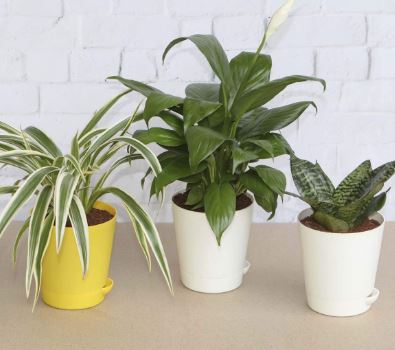We always use masks and take other preventive measures to save ourselves from air pollution. But, do you know the air inside your home is actually 2-5 times more polluted and toxic than the air you breathe outdoors?
A major source of indoor air pollution is mattresses we sleep on, sofas and other things at home. All these contain harmful chemicals and toxins.
But there is always a solution for every problem. Certain air-filtering plants, activated charcoal granules and natural oil blends, have been proven to remove harmful toxins and odours from the air we breathe, improving our health and longevity.
So, keep these six air-filtering plants to purify air at home:
Tulsi/Holy Basil/Ocimum tenuiflorum: Tulsi is a common houseplant in Indian households and is very helpful in keeping the air fresh and its presence creates an ambience. It is also known for its anti-inflammatory and anti-oxidant properties that help to combat a plethora of serious ailments like cancer, diabetes and heart diseases. It has antibiotic, antiviral, antibacterial and anticarcinogenic properties.
Aloe vera /A Barbadensis mill: Aloe plants are widely used for skincare and cosmetics. Famous for its anti-oxidants and anti-bacterial properties, aloe vera accelerates the healing of burns. That apart, it helps to treat mouth ulcers and lower blood sugar levels.
Lavender/Lavendula: There’s no doubt that lavender is one of the best aromatic flowers. Not only does it smell amazing but it also has many different uses like in teas, soaps, potpourri, insect repellents and even as an anti-inflammatory agent. Perhaps one of the best characteristics about lavender, beyond its incredible fragrance, is that it is easy to grow. It is used in soaps, shampoos, perfumes and essential oils. Known to cure ailments such as insomnia, anxiety, and depression, lavender is not only good in cleansing the body but also the mind and spirit.
Snake plant/Sansevieria trifasciata: This plant is best suited for bathrooms since it filters out formaldehyde, which is commonly found in personal care products. It is one of the top air-purifying plants identified by NASA. It is easy to grow and requires no extra attention. Even if you don’t water it every day, it will continue to give long with fresh leaves sprouting. The only thing to keep in mind is that it doesn’t easily rot and so it needs to be planted in free-draining soil. This plant is also called the mother-in-law’s tongue or Saint George’s sword.
Areca Palm/Dypsis lutescens: Areca Palm can be kept anywhere in the house but make sure it is not exposed to direct sunlight as that will make the leaves turn yellow. The plant can grow as high as 30 feet outdoors, but it is restricted to about seven feet at indoor locations. Put it in a small container and the crowded roots will help in limiting the size of the plant. The plant is useful in filtering xylene and toluene from the air. It also works effectively as an effective humidifier. Water enough to keep the soil moist and let it dry a little between waterings in winter.
Spider Plant: This lovely plant combats benzene, formaldehyde, carbon monoxide and xylene, a solvent used in the leather, rubber and printing industries. The plant derived this unique name due to its uniquely-shaped leaves, which dangle like spiders on a web. It is also completely safe if you have pets. If you see the plant turning a little brown, do not worry. It is normal and it will get back to its green self soon. Make sure you use well-drained soil and do not make the soil soggy for a fresh-looking spider plant.
PNN
